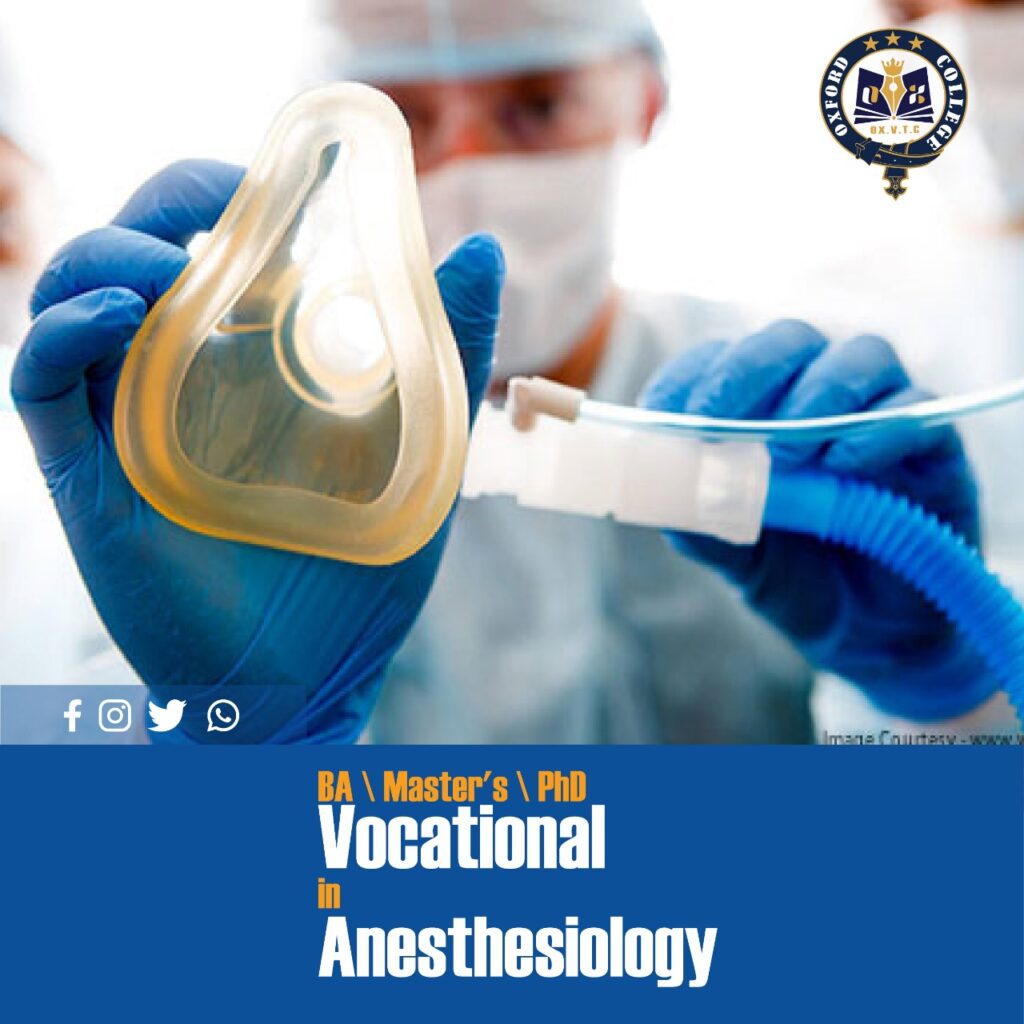Anesthesiology

اتصل بنا عبر البريد الإلكتروني على info@oxfordcollage.uk أو أرسل استفسارًا تجاريًا عبر الإنترنت.
who should attend?
who should attend?
objective
As a specialty, the core element of anesthesiology is the practice of anesthesia. This comprises
the use of various injected and inhaled medications to produce a loss of sensation in patients,
making it possible to carry out procedures that would otherwise cause intolerable pain or be
technically unfeasible.[17] Safe anesthesia requires in-depth knowledge of various invasive and
non-invasive organ support techniques that are used to control patients’ vital functions while
under the effects of anaesthetic drugs; these include advanced airway management, invasive
and non-invasive hemodynamic monitors, and diagnostic techniques like ultrasonography and
echocardiography. Anesthesiologists are expected to have expert knowledge of human
physiology, medical physics, and pharmacology, as well as a broad general knowledge of all
areas of medicine and surgery in all ages of patients, with a particular focus on those aspects
which may impact on a surgical procedure. In recent decades, the role of anesthesiologists has
broadened to focus not just on administering anesthetics during the surgical procedure itself,
but also beforehand in order to identify high-risk patients and optimize their fitness, during the
procedure to maintain situational awareness of the surgery itself so as to improve safety, as well
as afterwards in order to promote and enhance recovery. This has been termed “perioperative
medicine”.
The concept of intensive care medicine arose in the 1950s and 1960s, with anesthesiologists
taking organ support techniques that had traditionally been used only for short periods during
surgical procedures (such as positive pressure ventilation), and applying these therapies to
patients with organ failure, who might require vital function support for extended periods until
the effects of the illness could be reversed. The first intensive care unit was opened by Bjørn
Aage Ibsen in Copenhagen in 1953, prompted by a polio epidemic during which many patients
required prolonged artificial ventilation. In many countries, intensive care medicine is considered
to be a subspecialty of anesthesiology, and anesthesiologists often rotate between duties in the
operating room and the intensive care unit. This allows continuity of care when patients are
admitted to the ICU after their surgery, and it also means that anesthesiologists can maintain
their expertise at invasive procedures and vital function support in the controlled setting of the
operating room, while then applying those skills in the more dangerous setting of the critically ill
patient. In other countries, intensive care medicine has evolved further to become a separate
medical specialty in its own right, or has become a “supra-specialty” which may be practiced by
doctors from various base specialties such as anesthesiology, emergency medicine, general
medicine, surgery or neurology.
Anesthesiologists have key roles in major trauma, resuscitation, airway management, and caring
for other patients outside the operating theatre who have critical emergencies that pose an
immediate threat to life, again reflecting transferable skills from the operating room, and
allowing continuity of care when patients are brought for surgery or intensive care. This branch
of anesthesiology is collectively termed critical emergency medicine, and includes provision of
pre-hospital emergency medicine as part of air ambulance or emergency medical services, as
well as safe transfer of critically ill patients from one part of a hospital to another, or between
healthcare facilities. Anesthesiologists commonly form part of cardiac arrest teams and rapid
response teams composed of senior clinicians that are immediately summoned when a
patient’s heart stops beating, or when they deteriorate acutely while in hospital. Different models
for emergency medicine exist internationally: in the Anglo-American model, the patient is rapidly
transported by non-physician providers to definitive care such as an emergency department in a
hospital. Conversely, the Franco-German approach has a physician, often an anesthesiologist,
come to the patient and provide stabilizing care in the field. The patient is then triaged directly to
the appropriate department of a hospital.
The role of anesthesiologists in ensuring adequate pain relief for patients in the immediate
postoperative period, as well as their expertise in regional anesthesia and nerve blocks, has led
to the development of pain medicine as a subspecialty in its own right. The field comprises
individualized strategies for all forms of analgesia, including pain management during childbirth,
neuromodulatory technological methods such as transcutaneous electrical nerve stimulation or
implanted spinal cord stimulators, and specialized pharmacological regimens
content
content
Looking for higher education, at the postgraduate level (Master’s, Professional Doctorate) ?
